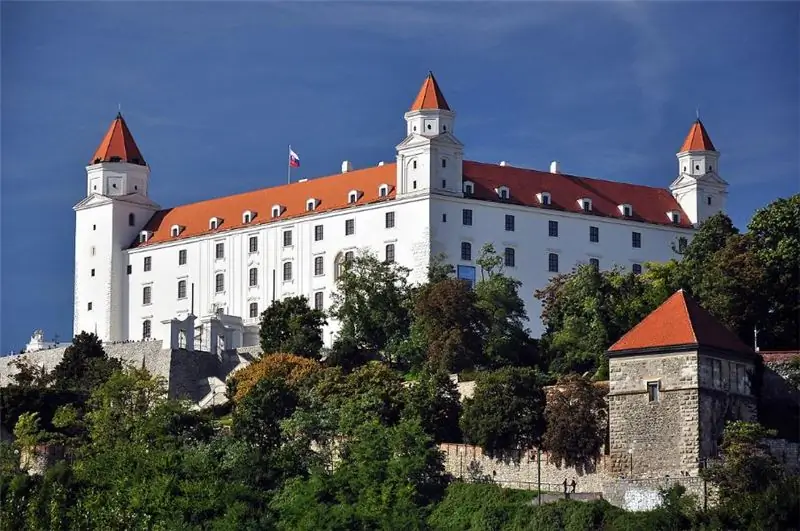
Picturesque Slovakia is very popular among tourists due to its stunning nature and curious history. For centuries, this territory was considered the border of Hungary, therefore impregnable fortresses and citadels were often erected here. There are so many of them that it is sometimes difficult to determine which are the most famous castles in Slovakia.
The main fortress in Slovakia is Bratislava Castle, located in the very heart of the country's capital. The castle overlooking the Danube was completely restored in the fifties of the XX century. The restorers have given it its appearance in accordance with the architectural style of the Theresian Baroque of the mid-18th century. The palace now functions as a historical museum of Slovakia and the seat of the parliament.
Among other famous citadels of Slovakia, the huge Spiš Castle, which stretches on the top of the mountain, stands out. It was built in the XI century and is surrounded by impregnable walls, the height of which varies from 20 to 40 meters. Now from this castle there are romantic ruins under the protection of UNESCO.
It is also worth noting the luxurious Nitra Castle, which previously belonged to powerful bishops. Here are preserved ancient bastions, a cathedral and a magnificent palace, where an interesting museum of ancient church books is now open. Also noteworthy is the Orava Castle, located on a steep cliff. This powerful medieval complex is built on several levels at once.
The romantic Bojnice Castle resembles a fairytale palace. It was completely rebuilt in the neo-Gothic style and decorated with graceful turrets. You can also go down to the stunning cave with stalactites and stalagmites, located in the dungeon of the castle.
TOP 10 popular castles in Slovakia
Spiš Castle
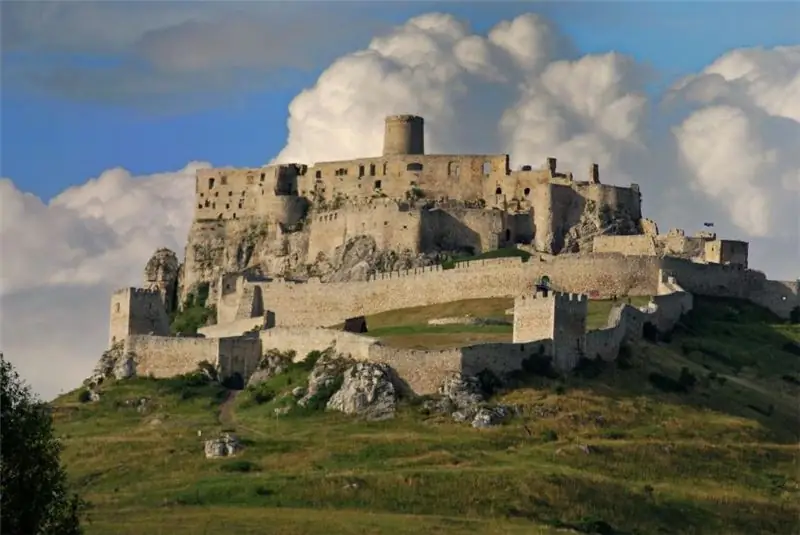
Spiš Castle
Spissky Castle is considered the largest castle in the whole of Central Europe and Slovakia in general. It covers an area of 4 hectares. In the distant 17th century, about two thousand people lived on its territory.
Spissky Castle stretches along the slope of a huge rock. The network of its fortifications begins at an altitude of 200 meters above sea level, while the main structures and the main palace are already located at a level of 634 meters. The height of the castle walls also ranges from 20 to 40 meters.
The castle was built in the 11th century, but the oldest surviving buildings date back to the middle of the 13th century. Most of the buildings were erected already in the 15th century, and after another hundred years new powerful bastions in the style of the Renaissance were added to the fortress. Since 1780, Spiš Castle has been in ruins, which have been carefully refined over the past centuries and turned into a museum. The entire architectural complex is under the protection of UNESCO.
Now the Spiš Castle is open to the public. Some of its buildings have been almost completely restored and various exhibitions are held there: archaeological finds, ancient weapons, instruments of torture. It is also worth visiting the splendid 15th century chapel, which has an unrivaled Gothic interior inside.
Zvolensky castle
Zvolensky castle
The monumental Zvolensky castle rises above the city of the same name. It was built by King Louis of Hungary in 1382 as a royal hunting residence. Subsequently, the castle acquired the features of a typical military architecture of the Renaissance.
The appearance of the fortress is distinguished by a series of medieval walls with partially preserved turrets. The lower floor of the main premises of the castle is made in the form of an arcade gallery. Some of the defensive elements of the Zvolensky Castle resemble the famous Moscow Kremlin.
The ancient fortress has been perfectly preserved. Now its luxurious halls are open for tourists. Particularly noteworthy are the richly decorated Late Gothic chapel and the huge hall, furnished in the Baroque style and decorated with portraits of kings and emperors from the Habsburg dynasty.
Some rooms of the Zvolen Castle belong to the Slovak National Gallery. It displays old sculptures and paintings, including works by the great masters - Paolo Veronese and Peter Paul Rubens.
Zvolen is located on the southern border of the huge Lower Tatras National Park. Another stunning medieval castle - Orava Castle - is located in the northern part of the park.
Nitran Castle
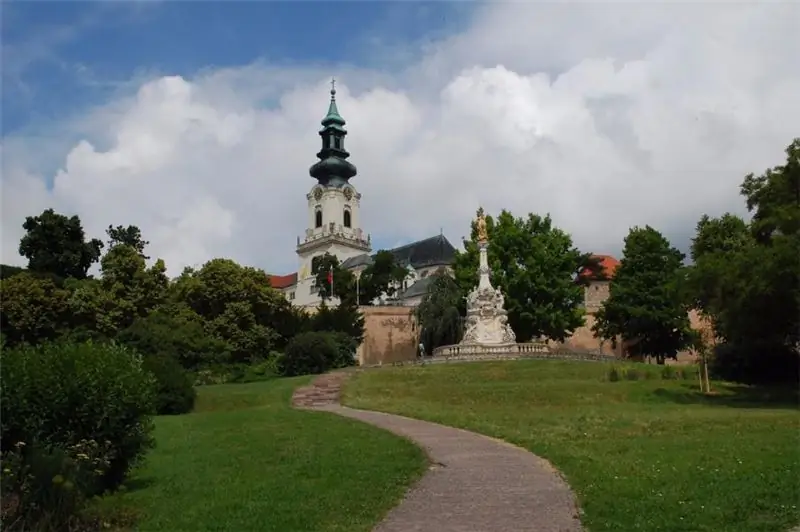
Nitran Castle
The luxurious Nitra Castle rises above the Old Town of the same name. Its history goes back over a thousand years and is closely associated with the powerful local bishops. An important shrine of the castle is the Cathedral of Saint Emmeram.
The first church on this site was founded back in 830, and a few years later the bishop's residence was located here. The appearance of a full-fledged fortress was officially recorded in the middle of the 11th century. The Nitra castle was repeatedly used for defensive purposes - it withstood the onslaught of the Mongol Tatars in 1241, but was taken by the Ottoman Turks in 1663.
The modern architectural appearance of the Nitra castle is dominated by the cathedral, which consists of several churches at once. The Episcopal Palace was completely rebuilt in the 18th century. The fortress wall and internal gate have survived from the Renaissance and date back to the 16th century, while other bastions were completed a century later.
The Cathedral of Saint Emmeram deserves a special mention. Its oldest part - a small Romanesque rotunda of the 11th-12th centuries - has survived to this day. Now it houses an expensive silver reliquary from 1674. The upper church from the 14th century is a masterpiece of Gothic architecture, while the lower one, later, is luxuriously furnished in Baroque style. The basilica of St. Emmeram contains the relics of St. Cyril, the creator of the Slavic alphabet.
Also on the territory of the Nitra castle is an interesting diocesan museum, which displays the treasury of the episcopal palace and rare church books.
You can get to Nitra by a comfortable train from Bratislava, located 90 kilometers to the west.
Budatinsky castle
Budatinsky castle
The romantic Budatinsky castle is located not far from the center of the large city of Zilina. The first building appeared here in the XIII century - then there was an important customs post here. A hundred years later, it was occupied by the famous Matus Cak, the uncrowned king of Slovakia. Under him, the building was additionally fortified and turned into a full-fledged fortress.
Subsequently, the fortress was rebuilt several times. The main palace was rebuilt in the Renaissance style. By the 17th century, the castle lost its defensive purpose, so the powerful ancient fortifications were demolished. At the same time, elegant Baroque buildings were erected, including a chapel. The entire palace complex has acquired a recognizable white color.
The dominant feature of the architectural appearance of the Budatyn castle is a huge four-story tower of the XIV century. Its exterior even features Gothic-style features - a jagged top and tiny windows.
Now there is a museum in the castle. Separate rooms are open for visiting, where a stunning old interior has been preserved - on the ground floor, for example, you can admire a unique fireplace in the Renaissance style. A separate exposition is dedicated to sacred paintings and precious church utensils of the 18th-19th centuries. Of particular interest are the exhibits of the Povazh Museum, dedicated to the folk crafts of the local region.
Trenčiansky castle
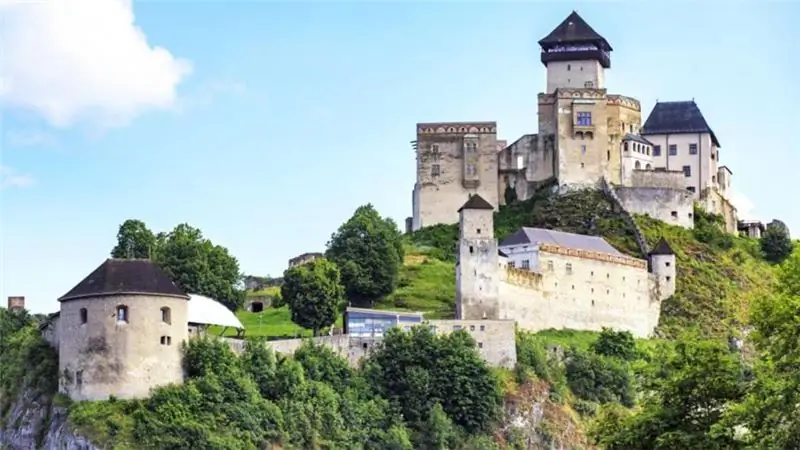
Trenčiansky castle
The industrial town of Trencin is dominated by the castle of the same name, which is considered one of the largest in all of Slovakia. The first buildings on this site appeared in the 11th century. The oldest building is the Matusova Tower, rebuilt in 1270 in the Gothic style. At the same time, the castle was owned by Matus Cak, a Hungarian tycoon known as the “uncrowned king of Slovakia”.
Several ancient palaces of the XIV-XVI centuries have survived on the territory of the fortress: Louis, Barbara and Zapolsky, respectively. Of particular interest are the fortifications on the southern, least protected side of the castle. This unique complex appeared in the XV-XVIII centuries in accordance with the development of military technology. It consists of three walls, two moats and two bastions for artillery. However, some defensive fortifications have survived from earlier times. For example, in the basement of the Royal Tower of the 15th century, a terrible prison was located for many centuries.
A museum is now open in the premises of the Trenčiansky castle, where archaeological finds, antiques, antique furniture, a collection of weapons and paintings are presented.
A romantic legend is associated with the fortress - on its lower tier there is an ancient well of the 16th century, reaching 80 meters in depth. According to legend, the Turk Omar dug through it to return his kidnapped bride from the owner of the castle. And on the rock from which the Trenchyansky castle grows, there is an inscription in Latin dated 179 and confirming that the northern border of the Roman Empire passed here.
Orava Castle
Orava Castle
Orava Castle attracts thousands of tourists due to its favorable location - in the immediate vicinity of the Lower Tatras National Park and various mountain resorts. The castle itself rises on a sheer cliff. It was built in the 13th century and was subsequently rebuilt and further strengthened many times. However, most of its buildings were made of wood, so the fire of 1800 proved fatal for the Orava Castle. The modern appearance of the fortress dates back to the middle of the 20th century. It was carefully given features of the Renaissance and Baroque styles.
Orava Castle was built on several levels at once, differing in height. The lower tier is represented by a powerful fortress wall and small turrets, and at the very top there is a magnificent palace. Separate parts of the castle are connected by stairs.
In 1868, the Orava Museum was opened on the territory of the castle. Various historical and ethnographic collections, archaeological finds and much more are presented here. In some of the rooms, a unique interior with antique furniture has been restored. The curious armory and the splendid art gallery are also worth a visit. The palace chapel also deserves special attention, inside of which the Baroque decoration of the mid-18th century has been preserved.
Growing out of the cliff, the Orava Castle is a unique sight. He has repeatedly "participated" in the filming of popular films, including the classic horror film "Nosferatu".
Bojnice Castle
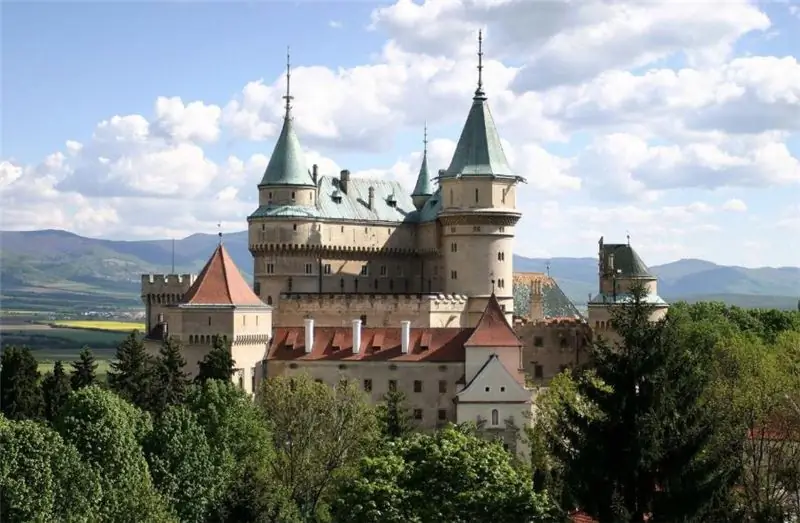
Bojnice Castle
The stunning Bojnice Castle combines several architectural styles in its appearance. It resembles a palace from a fairy tale and rises above a picturesque valley.
Bojnice Castle has been known since the 11th century. Among its owners, it is necessary to note the famous Hungarian magnate Matus Cak, the nominal ruler of Slovakia, as well as the powerful King of Hungary Matthias I. An ancient linden tree has been preserved in the palace park, under which, according to legend, King Matthias drew up his decrees. If the legend is true, then this tree is over 500 years old!
The romantic love story of its owner from the Palffy family to a French aristocrat, for the sake of which he built several luxurious palaces similar to the famous castles of the Loire Valley, is associated with the modern appearance of the castle. The work was carried out from 1889 to 1910, but the unfortunate lovers never managed to live here.
The monumental Bojnice Castle is surrounded by a powerful fortress wall with graceful turrets and bastions. By the way, one of them houses a chapel, inside of which the unsurpassed interior of the 17th century has been preserved. The chapel is richly decorated with frescoes and stucco. Prominent representatives of the Palfi family are buried in the crypt; from there there is also a secret underground passage to an amazing cave, where you can see the mysterious interweaving of stalactites and stalagmites.
Many other rooms of the castle are also open for visiting: the Gothic chambers of the main palace, a luxurious golden hall with a wooden ceiling … The premises have preserved antique furniture, paintings, and decorative and applied arts. Particularly noteworthy is the stunning Bojnice Altarpiece, made on a wooden board in the middle of the 14th century.
Bojnice Castle consists of several tiny courtyards with charming wells. It is also surrounded by a huge park that smoothly flows into the city zoo, where lions, lynxes, ungulates, owls and a variety of monkeys are found.
Krasna-Gorka castle
Krasna-Gorka castle
Krasna Gorka Castle rises on a hill in the middle of a picturesque valley near the Hungarian border. There are many cliffs with frightening caves and splendid castles on the tops. Krasnaya Gorka is one of these fortresses.
It is believed that the first building appeared on this place in the XIII century - here the Hungarian king Bela IV was hiding from the Mongol-Tatars. And in the 16th century, this small fortification grew into a luxurious Renaissance-style castle, which repeatedly repelled the attack from the Turkish troops. At the same time, the owner of the castle changed - now it passed into the hands of the eminent Hungarian noble family of Andrássy. They also took up the restoration of the castle at the beginning of the 20th century and opened an interesting museum here.
Despite the recent fire in 2012, the Krasna-Gorka castle is in excellent condition. The fortress consists of a chain of defensive fortifications and nice round turrets. Inside, stunning interiors, antique furniture, glassware, a collection of weapons and even carriages have been preserved. Medieval cuisine deserves special attention, presented in an almost unchanged form. It is also worth visiting the castle chapel, where the mummified body of Sophia Seredi, the wife of one of the Andrássy family, lies in a glass coffin.
By the way, in the immediate vicinity of the castle there is a monumental mausoleum of the Andrássy family, made in the form of a rotunda. Burials of especially eminent members of this family take place here today.
Budmeritsa and Cerveni-Kamen

Cherveni-Kamen castle
30 kilometers from Bratislava, there are two pretty, but so different from each other castles - Cherveni Kamen and Budmeritsa.
The name "Cherveni-Kamen" is translated as "red stone", but the modern building is painted in a delicate cream color. The first fortress appeared on this site in the 13th century. Three hundred years later, the castle passed to the Fugger family of famous German merchants and was rebuilt in the Renaissance style. By the way, Albrecht Durer himself worked on the creation of new defensive lines. Now the luxurious interiors of the Cherveni Kamen castle are open for tourists. Of particular note is the richly marbled chapel and the curious pharmacy, where the unrivaled interior of the mid-18th century has been preserved.
The Cherveni-Kamen castle also hosts a variety of exhibitions dedicated to the life of the nobility. Here you can see antique furniture, a collection of weapons, porcelain products and much more.
In the vicinity of the Cherveni-Kamen castle there is a luxurious two-storey mansion Budmeritsa, built much later than the medieval fortress - in 1889.
The Cherveni Kamen castle and the adjacent lands belonged to the noble Hungarian family of Palfi. One of its representatives fell in love with a French aristocrat and for her sake built several palaces at once, reminiscent of the famous castles of the Loire Valley. Budmerice is one of such monuments of this love story. A huge landscape park with artificial lakes and romantic gazebos has grown around the snow-white mansion. The old church of 1722 and the pretty Baroque chapel of the Virgin Mary of the Seven Sorrows perfectly fit into this palace and park ensemble.
Budmerice Castle now belongs to the Slovak Writers' Union and is therefore closed for tourist visits. And you can walk through the picturesque park almost at any time.
Smolenice Castle
Smolenice Castle
Smolenice Castle is located on a hill at the foot of the enchanting Carpathian Mountains. The first defensive building appeared here in the XIV century and belonged to the king himself. Subsequently, the castle changed many owners - representatives of the eminent Hungarian families Erdödi and Palfi.
Smolenice Castle fell into complete desolation after the devastating wars with Napoleon. Only a network of defensive fortifications has survived from the original Gothic building, on the foundations of which new ones were erected in 1887. Construction dragged on for several decades, and the world wars that broke out one after another did not contribute to progress. Ultimately, the Smolenice castle was completed already in the fifties of the XX century, when the Pálfi family left Slovakia long ago.
Smolenice Castle is made in the neo-Gothic style, the dominant feature of the whole building is a powerful high tower topped with a cone-shaped roof. A huge staircase with 156 steps leads to the main buildings of the fortress.
The castle is the property of the Slovak Academy of Sciences, therefore it is open for visits only in summer. The interior furnishings are predominantly in the romantic neo-Gothic style, but later rooms were completed already in the fifties of the 20th century. Here you can see the Soviet ceramic tiles so familiar to us, as well as curious mosaics.
Despite its modern appearance, Smolenice Castle is very popular among tourists. Surrounded by a lush garden, the fortress resembles a fairytale palace. Moreover, the castle is easy to reach - there is a train from Bratislava and a bus from neighboring Trnava.






